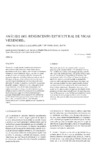Mostrar o rexistro simple do ítem
Análisis del rendimiento estructural de vigas Vierendeel
| dc.contributor.author | Estévez-Cimadevila, Javier | |
| dc.contributor.author | Martín-Gutiérrez, Emilio | |
| dc.date.accessioned | 2020-02-24T12:19:18Z | |
| dc.date.available | 2020-02-24T12:19:18Z | |
| dc.date.issued | 2003 | |
| dc.identifier.citation | ESTÉVEZ-CIMADEVILA, Javier; MARTÍN-GUTIÉRREZ, Emilio. Análisis del rendimiento estructural de vigas Vierendeel. Informes de la Construcción, 2003, vol. 54, no 483, p. 27-37. | es_ES |
| dc.identifier.issn | 0020-0883 | |
| dc.identifier.issn | 1988-3234 | |
| dc.identifier.uri | http://hdl.handle.net/2183/25011 | |
| dc.description.abstract | [Resúmen] El presente artículo aborda el análisis del rendimiento estructural de vigas Vierendeel. Dicha valoración se determina a través de dos índices, uno relativo al rendimiento resistente y otro al rendimiento global, que tiene en cuenta además la rigidez del conjunto a flexión. Los resultados mostrados responden al análisis y dimensionado de más de 400 vigas, en las que se han utilizado una serie de cinco modulaciones en combinación con siete valores de canto diferentes. El estudio se completa con el empleo de dos tipos de perfiles (tubular y abierto) y con la comparación de su comportamiento con el de las vigas trianguladas. Las gráficas aportadas constituyen una herramienta de gran utilidad en orden a valorar la incidencia de los parámetros de diseño de estas vigas en su rendimiento estructural, poniendo de manifiesto como conclusión más relevante la pérdida de eficiencia que se produce, en un dimensionado optimizado, con la utilización de cantos elevados, contrariamente a los criterios vigentes en las soluciones de celosía. | es_ES |
| dc.description.abstract | [Abstract] This article approaches the analysis of the structural efficiency of the Vierendel beams. This assessment involves two variables: one relates to the strength-efficiency and the other one to the global efficiency. (The global efficiency takes also into account the bending stiffness of the beam). The results shown reflect the analysis and dimensioníng of over 400 beams, where a series of five different modulations combined with seven different beam depths have been used. The case study finishes using two types of profiles (hollow and open section) and comparing the structural behaviour between beams and trusses. The graphs shown are a very useful tool in order to assess the effect of these beams'design parameters on their structural efficiency. The most important result of the case study is the fact that using high beam depths in an optimized dimensioning involves a decrease of the efficiency. This criteria differs from the criteria for latticed structures. | es_ES |
| dc.language.iso | spa | es_ES |
| dc.relation.uri | informesdelaconstruccion.revistas.csic.es/index.php/informesdelaconstruccion/article/view/573/648 | es_ES |
| dc.rights | Atribución-NoComercial 3.0 España | es_ES |
| dc.rights.uri | http://creativecommons.org/licenses/by-nc/3.0/es/ | * |
| dc.title | Análisis del rendimiento estructural de vigas Vierendeel | es_ES |
| dc.title.alternative | Analysis of structural efficiency of Vierendeel beam | es_ES |
| dc.type | info:eu-repo/semantics/article | es_ES |
| dc.rights.access | info:eu-repo/semantics/openAccess | es_ES |
| UDC.journalTitle | Informes de la Construcción | es_ES |
| UDC.volume | 54 | es_ES |
| UDC.issue | 483 | es_ES |
| UDC.startPage | 27 | es_ES |
| UDC.endPage | 37 | es_ES |
Ficheiros no ítem
Este ítem aparece na(s) seguinte(s) colección(s)
-
GI-GEA - Artigos [66]






